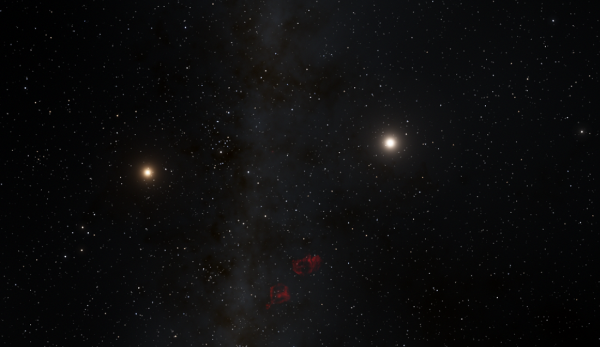BY LETTER
Hamashta (p Eridani)
Galactography > Regions of Space > Inner Sphere
Galactography > Systems and Worlds > Systems & Worlds G - H
Galactography > Systems and Worlds > Systems & Worlds G - H
 Image from Steve Bowers | |
| The two stars of Hamashta | |
Hamashta System - Data Panel | |
| System | Name: Hamashta Components: 2 1) Haomeda (p Eridani A) 2) Tikhouno (p Eridani B) Location: - Distance from Hwii: 6.338 ly (J2000) - Distance from Sol: 26.73 ly (J2000) - Constellation: Eridanus |
|---|---|
| Haomeda | Names: Haomeda, p Eridani A, Gliese 66 A (GJ 66 A), HD 10360, HIP 7751 A, HR 486 Physical characteristics: - Mass: 0.78 x Sol - Radius: 0.76 x Sol - Temperature: 5,083 Kelvin - Luminosity: 0.35 x Sol (bolometric) - Spectral type: K2 V - Rotation period: 30 days - Age: 4.94 billion years |
| Tikhouno | Names: Tikhouno, p Eridani B, Gliese 66 B (GJ 66 B), HD 10361, HIP 7751 B, HR 487 Physical characteristics: - Mass: 0.77 x Sol - Radius: 0.72 x Sol - Temperature: 5,073 Kelvin - Luminosity: 0.31 x Sol (bolometric) - Spectral type: K2 V - Age: 4.94 billion years |
| Binary orbit | Orbital characteristics: - Average separation: 65.3 AU - Orbital period: 493.3 years - Eccentricity: 0.499 |
Refugees from the Great Expulsion from Earth departed the Solar System in 692 AT in the Shorelark, a Skylark class ship, assisted by the Goddess of Earth (GAIA). They reached p Eridani in 820 AT, constructed several rotating space habitats and colonised a number of small planetoids. They gave the star and system the name Hamashta.
Hamashta joined the Eridanus League in 846 AT, and sent system control ships to Eunchong to help suppress a rebellion in 1440.
On the breakup of the League, it joined the NoCoZo. Starting in 6509 AT, a program of building Bishop Rings was commenced, and this system now contains forty-two examples of this kind of megastructure.
Related Articles
Appears in Topics
Development Notes
Text by Steve Bowers
Initially published on 05 October 2016.
System data panel and additional information added by The Astronomer + Name changed to 'Hamashta' 2021
Initially published on 05 October 2016.
System data panel and additional information added by The Astronomer + Name changed to 'Hamashta' 2021






